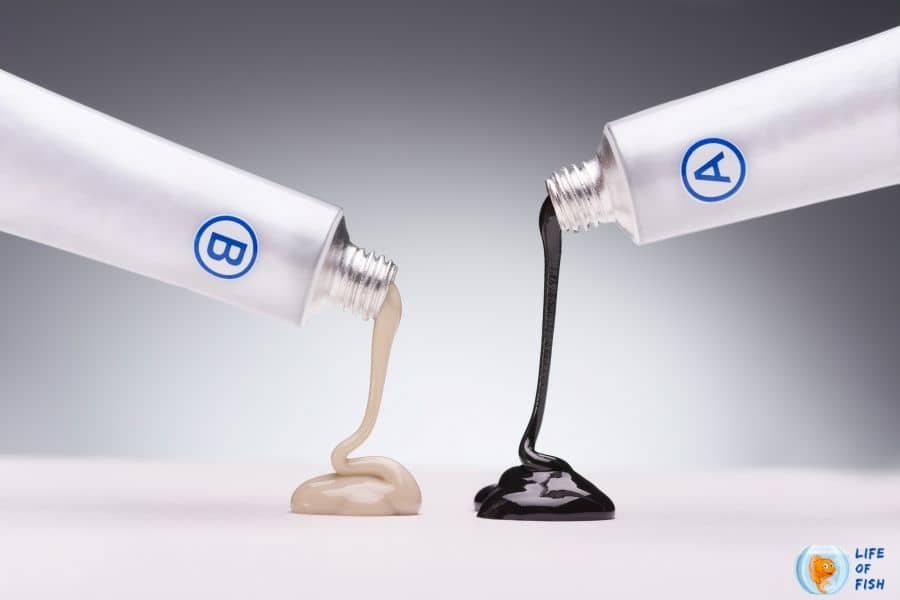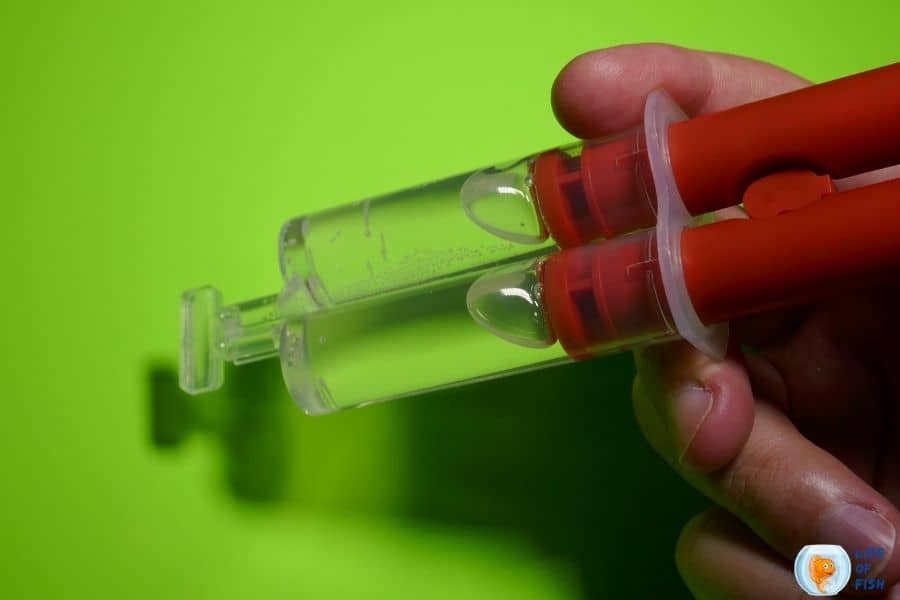Epoxy is a highly versatile and extremely strong adhesive used in many DIY projects. It is used for bonding metal, glass, wood, plastic, and ceramic. It is also used to make beautiful mosaics or even repair cracked tiles on the wall. This is an adhesive so powerful that it can bond almost anything, so the question often arises, Is epoxy a safe aquarium glue?
The answer is yes. Epoxy is safe for aquarium use. However, it needs to be completely cured, and there are drawbacks too. Let us have a look at how this glue can be used in our aquariums.
Many aquarists love to use this glue in their aquariums because of the numerous benefits it offers.

What is epoxy glue?
Jump To
- 1 What is epoxy glue?
- 2 Is epoxy glue safe for aquariums?
- 3 What is 2 part epoxy?
- 4 Is 2 part epoxy aquarium safe?
- 5 Is 2 part epoxy reef safe?
- 6 How to use epoxy for setting up an aquarium?
- 7 How to remove epoxy from the aquarium?
- 8 How long does 2 part epoxy take to dry?
- 9 Is marine epoxy safe for aquariums?
- 10 What is the best epoxy for aquariums?
- 11 How do you use aquarium epoxy?
- 12 Safety precautions while using epoxy glue
- 13 Benefits of Epoxy Glue for Aquarium Use
- 14 Drawbacks of Epoxy glue for aquarium use
- 15 Conclusion
Epoxy glue is a two-part epoxy adhesive containing part A and part B.
These are included in separate tubes, which must be mixed together quickly before use because the chemical reaction starts as soon as these two parts are combined.
The mixing ratio is usually 1:1, and epoxy glue is used for applications that need a high strength bond. It can also be colored easily to create any color.
Is epoxy glue safe for aquariums?
Epoxy is not a corrosive glue as it does not contain any acid or base. Once cured, it will not corrode the surface and mix any harmful compounds into the water.
Epoxy is completely inert once completely cured. So, it is usually safe for aquariums. However, epoxy can be dangerous to humans and aquarium inhabitants if used incorrectly.
What is 2 part epoxy?
Two-part epoxy is another name used for epoxy glue. It is really popular by the name because it consists of 2 parts – a resin and a hardener.
These parts are mixed together to form a thick liquid adhesive that can be used for curing glass, ceramic, metal, etc.
Is 2 part epoxy aquarium safe?
Yes. As we explained before, epoxy is entirely inert once cured. It will not mix with the water or corrode the aquarium walls.
You can use this adhesive to create any pattern or mosaic in your aquarium without worrying about the effect on the inhabitants.
Is 2 part epoxy reef safe?
Two-part epoxy is reef safe, but it tends to break down in saltwater even after completely cured.
The adhesive breaks down in salt water due to the deterioration of the resin component. The best adhesive for setting up a tank containing fish, corals, and other invertebrates is acrylic sealant because it provides a strong chemical bond.
How to use epoxy for setting up an aquarium?
Step 1: First, clean the surface with acetone or alcohol before applying the epoxy. This is very important as oil or dirt can stop the adhesive from curing properly.
Step 2: Once this is done, mix the epoxy and the hardener in one to one ratio in a container. You can use gloves while mixing epoxy to protect your hands.
The reaction starts as soon as these two are combined, so you have very little time to mix them thoroughly.
Do not try to mix the epoxy with a paintbrush, as you will not be able to do this within 5 minutes. Do not mix more as it tend to harden faster. Once solidified, you can not soften the mixture again.
Step 3: Now, apply a thin layer of the mixture onto the surface.
Step 4: Now, place the objects carefully on the adhesive and let them dry for 24 hours before using.
Epoxy gives a solid bond, but it can cause severe skin irritation, so it is advisable to wear gloves while mixing the two parts and handling the adhesive.
How to remove epoxy from the aquarium?
It is difficult to remove the epoxy once it has dried completely. You can use acetone or alcohol for removing epoxy by dissolving it, but this process may damage the surface you are working on.
If you want to recycle or reuse any objects made with two-part epoxy, you should consider removing the adhesive before doing so.
How long does 2 part epoxy take to dry?
Epoxy takes about 24 hours to cure completely. It is much harder than other glues and has very strong chemical bonds with the surface making it resistant to impacts.
You cannot remove epoxy once it has dried completely. The only way to recycle the objects is by removing epoxy from the surface using acetone or alcohol.

Is marine epoxy safe for aquariums?
Marine-based epoxy is both safe and strong for aquarium use. Epoxy glue is entirely inert once it has dried and does not dissolve in water.
It will remain strong even if the aquarium inhabitants try to break it down or scratch it with sharp objects.
Since marine epoxy gives a solid bond, you can use it to attach objects such as coral frags and rocks to your reef tank. Marine-based epoxy is the adhesive product used by professional aquarists and hobbyists.
What is the best epoxy for aquariums?
It is difficult to say which epoxy is the best because they all serve different purposes.
You can use marine-based epoxy to attach reef-safe objects in your saltwater aquarium, but you must consider whether it will be strong enough for your needs.
If you are worried about how water will affect epoxy, you can use two-part freshwater aquarium glue, which is both safe and strong for an aquarium.
How do you use aquarium epoxy?
To use epoxy for aquariums, mix equal amounts of resin and hardener thoroughly before applying it onto the objects to be glued.
You will have to follow safety precautions during the whole process as the chemicals in epoxy are irritating to both skin and eyes.
It is also hazardous when swallowed. When using resin or hardener, make sure you always use fresh air while breathing in the vapors so that you do not get trapped inside your house.
You will have to work as fast as possible because once the resin and hardener are mixed, it tends to harden faster, within minutes.
Once the epoxy is on the objects, you can place them carefully to stick together. You have to leave it for 24 hours before using them. Epoxy does not dissolve in water and leaves a transparent bond on the surface of the objects.
Safety precautions while using epoxy glue
Epoxy resin is hazardous when mixed with the hardener. So, you must take safety precautions to be safe.
- Wear gloves to protect your hands
- Stay in a good ventilation area while working
- Wear a plastic apron to protect your body
- Wear safety goggles
- Use a respirator (This is not required for some epoxy glue products)
Benefits of Epoxy Glue for Aquarium Use
When the epoxy is used as a sealant, it can last for over ten years in your aquarium.
It can be used inside your tank to seal cracks and leaks, but it is more popular among aquascapers who use it to attach objects such as rocks and coral frags in their aquarium.
Drawbacks of Epoxy glue for aquarium use
As epoxy is a chemical, it is poisonous if put in the aquarium before curing it completely.
Although you want to make things faster, it is better to keep your epoxy glued object outside the aquarium for at least 24 hours. Otherwise, it can harm your aquarium inhabitants.
Further, this slow-curing glue takes 24 hours before it becomes ready for use. So, if you want some glue to fix small parts and need the glued object fast, epoxy wouldn’t be the right choice. For that, we recommend “Super Glue.”
Conclusion
Epoxy is a versatile, strong adhesive used in many DIY projects. It securely bonds metal, glass, wood, plastic, and ceramic and is inert when cured.
This makes it safe for aquariums in most cases. If you are interested in using epoxy for your next project, be sure to check if it is aquarium safe to be confident when using it in your aquarium.
Do not forget to take safety precautions when working with epoxy resin and hardeners, so you do not get hurt.
Read Next : Is Krazy Glue Safe For Aquariums ? | A Crazy Answer For You | Can You Use Distilled Water In A Fish Tank? (No, Read Why!) API General Cure ( Is This A Cure For Everything?)
